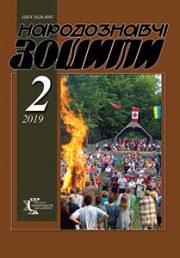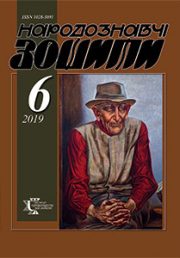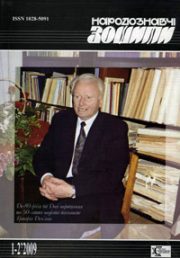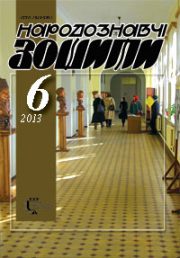The Ethnology Notebooks. 2020. # 1 (151). P. 1–248
DOI https://doi.org/10.15407/nz2020.01

Folk Art in Interdisciplinary Discourse: History, Theory, Methodology, Terminology
HERUS Lyudmyla
PRESERVATION OF THE INTANGIBLE CULTURAL HERITAGE: UKRAINIAN EXPERIENCE
3—14
SELIVACHOV Michael
ANTHROPOMORPHIC SIGNS / IMAGES OF FOLK UKRAINIAN ORNAMENT: PAGAN RELICTS, FOLKLORE SYMBOLS, MYTHOLOGY OF A FAKELORE
15—20
KOZINCHUK Vitaliі
«ZVENYHORODSCHYNA. SHEVCHENKO’S HOMELAND FROM AN ETHNOGRAPHIC AND DIALECTOLOGICAL POINT OF VIEW» AS A SOURCE FOR LEARNING TRADITIONS OF THE DOMESTIC ICON
21—26
TRISKA Oksana
THE PEDAGOGICAL ASPECTS OF THE UKRAINIAN CANONICAL ICONOGRAPHY AT THE BORDER OF THE XVII—XVIII CENTURY
27—35
MOLYN Valentyna
KATTRYNA ROMANIVNA SUSAK: TEACHER, LTADER, RESEARCHER AND MASTER OF EMBROIDERI, PUBLIK FIGURE
36—48
YAMBORKO Olha
UKRAINIAN INDUSTRIAL CARPETMAKING AS A BRAND IN THE SOVIET SYSTEM OF ARTS AND CRAFTS
49—59
The Place and Role of Folk Art in the Cultural Space of the XXI Century: Art Centres, Masters, Artistic Ideas
NYKORAK Оlena, KUTSYR Tetiana, KUMPIKAITE Egle, MILASIENE Daiva, RUKUIZIENE Zaneta, NENARTAVICIUTE Erika
WESTERN UKRAINIAN AND LITHUANIAN BEDSPREADS: DECOR ETHNO-ARTISTIC TRADITION PARALLELS
60—92
IVASHKIV Halyna
THE SACRAL EARTHENWARE FROM IVAN LEVYNSKYY’S FACTORY IN LVIV (IN COMMEMORATION OF HIS 100TH DEATH ANNIVERSARY)
93—108
GAIDAMAVICIUTE Ona
BIRD SYMBOLISM IN LITHUANIAN (BALTIC) FOLKLORE AND FOLK ART
109—116
CHIKH-KNYSH Bohdana
RICHKA MASTERS OF INLAYON WOOD. FOLLOWING TRADITIONS AND FORMALISM OF FOLK ART
117—125
BOLYUK Oleh
THE ANCIENT ART OF WOOD CARVING OF BOYKOS: ARCHAIC MONUMENTALITY AND «PAINTING» GEOMETRY
126—137
Folk and Academic Art, Relationships and Mutual Influences
MOTYL Romana
INTERNATIONAL CERAMICS SYMPOSIUM IN LELIŪNAI (LITHUANIA): TRADITIONS, ARTISTIC SEARCHINGS, ACHIEVEMENTS
138—146
STUDENETS Natalia
PODILLIA’S DOMESTIC MURAL PAINTING WITHIN MODERN ARTISTIC PRACTICES
147—154
BEREZUTSKA Maryna
A’CAPELLA IN THE REPERTOIRE OF BANDURA PLAYERS AS A MODERN ENTITY OF UKRAINIAN MUSIC (an example of Dnipropetrovsk bandura players ensemble «Charivnitsy»)
155—164
SHCHERBAN Anatoliy, KOTLYAR Yevgen
ARCHITECTURAL SKETCHES BY MYKHAYLO DYACHENKO
165—176
GAVRYLYUK Alla
THE ROLE OF FAMILY TRADITION IN THE FORMATION OF A CREATIVE PERSON (FOR EXAMPLE, FIVE GENERATIONS OF SELIVATCHOVS)
177—189
Folk Art in the Practice of Educational Institutions
FRUNZE Olena, BABINA Yuliana
POTTERY AS AN ETHNIC PHENOMENON OF TRANS BORDER OF FOLK ART AND AS AN ARTISTIC DISCIPLINE IN THE PRACTICES OF HIGHER EDUCATION INSTITUTIONS OF THE REPUBLIC OF MOLDOVA
190—199
Preservation and Promotion of Museums and Private Collections of Folk Art
FABRYKA-PROTSKA Olga
FESTIVAL «LEMKO’S VATRA» AS AN IMPORTANT PART OF THE ARTISTIC UKRAINIAN-POLISH COOPERATION
200—206
Articles
KUPCHYNSKA Larysa
THEODOR YAKHYMOVYCH (BASED ON YAROSLAVA MUZYKA’S ARCHIVE)
207—219
MOSKAL Marta
THE THEME OF THE STRUGGLE OF THE HOLY WARRIORS WITH EVIL IN UKRAINIAN RELIGIOUS ART OF THE XII—XVIII CENTURIES
220—228
ODREKHIVSKYI Roman
TRADITIONS OF FOLK ART IN FORMATION AND DEVELOPMENT OF THE ENVIRONMENTAL DESING OF THE SACRAL BUILDINGS IN GALICIA (THE FIRST THIRD OF XX CENTURY)
229—232
SHPAKOVYCH Oksana
THE STAGE DESIGN BY MYRON KYPRIIAN IN 60S OF THE TWENTIETH CENTURY
233—244








